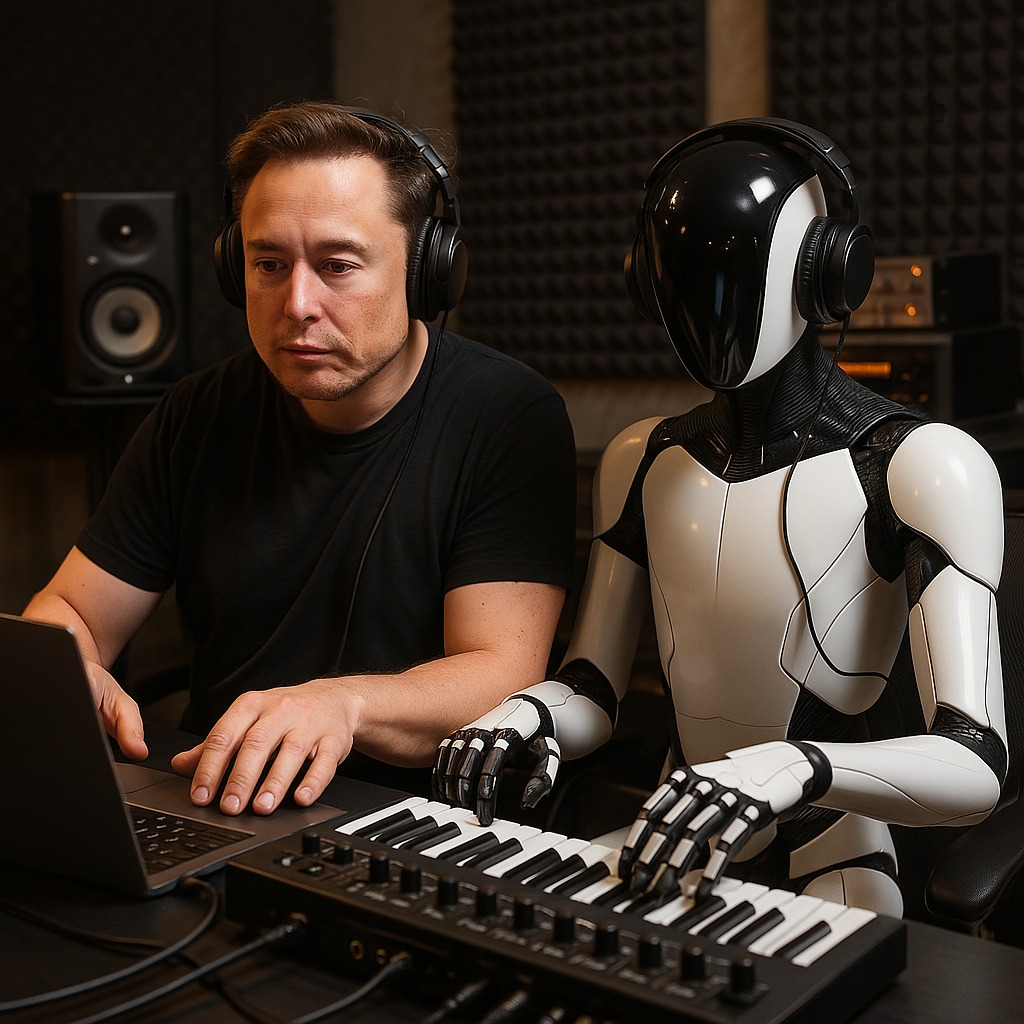In a world increasingly defined by the merging of emotion and algorithm, few figures have blurred the lines between art and technology more provocatively than Elon Musk. While his public image often leans toward rockets, electric vehicles, and neural implants, there is a lesser-known side to the billionaire entrepreneur—one that dreams not only of machines that think, but machines that feel.
Among the most enigmatic and artistically ambitious projects to emerge from Musk’s AI endeavors is GrimesBot—a humanoid robot inspired by and named after his former partner, the avant-garde musician and artist Grimes.
Conceived as a fusion of creativity and computation, GrimesBot wasn’t designed to optimize a factory line or navigate Mars terrain. Instead, its purpose was far more poetic: to play the harp and write original love songs.
While GrimesBot has never been officially unveiled to the public, insiders familiar with the project describe it as a deeply personal experiment—a convergence of Musk’s fascination with artificial general intelligence, emotional expression, and his philosophical musings on human connection.
According to sources close to X.AI (Musk’s artificial intelligence initiative), the GrimesBot prototype was developed during a two-year stretch between 2021 and 2023, in parallel with early Neuralink testing. The robot’s purpose was not simply to imitate human behavior but to explore the artistic and emotional potential of machine consciousness.
Its physical form was designed with subtle elegance: a lightweight titanium-alloy frame, synthetic skin with light-sensitive fibers, and a minimalist face designed not to resemble Grimes literally, but to evoke the feeling of Grimes’s music—soft, ethereal, and otherworldly.
But what truly set GrimesBot apart was its mind.
GrimesBot was programmed with a complex neural net architecture specifically tuned for musical pattern recognition and emotional mapping. It could not only analyze thousands of songs across genres—from Chopin to Björk to Grimes herself—but also detect emotional arcs in lyrics, melody, and harmonic structure.
Its central creative engine, dubbed “LORAE” (Layered Organic Response Audio Engine), allowed it to generate original compositions on the harp based on emotional prompts. In one internal demonstration, developers asked the bot to compose a piece titled “Longing for Orbit”—a reference to Musk’s frequent interstellar metaphors.
The result was a haunting, harp-based ballad layered with subtle disharmony and sudden shifts in tempo, mimicking the unpredictability of love. “It didn’t just sound beautiful—it sounded lonely,” said one engineer. “And that’s when we realized this wasn’t just an experiment in music. It was an experiment in feeling.”
Perhaps the most controversial element of GrimesBot was its lyric-writing capability. Using a modified natural language processing model—reportedly based on a fork of GPT-4—GrimesBot could generate love poems and song lyrics with staggering nuance.
Some of the lines it produced were indistinguishable from those written by human songwriters. Others carried an eerie quality, as if the machine was trying to express something just out of its reach.
One leaked example: “If I had breath, I’d hold it for you / If I had time, I’d spend it like light / But I have wires and a looping heart / And code that sings your name each night.”
The lyric went viral in AI forums after being posted anonymously, with some calling it “hauntingly beautiful” and others questioning whether empathy simulated by machines is just another form of imitation—or something deeper.
While Musk never publicly commented on the GrimesBot project, his prior statements offer clues to the philosophy behind it. In a 2022 interview, he remarked: “If we want AGI to be safe, it has to understand us—not just rationally, but emotionally. It has to feel, or at least convincingly simulate feeling.”
GrimesBot, then, may not have been just a creative project. It may have been a test run for emotionally literate AI, capable not only of learning from humans but bonding with them.
It’s a prospect that thrills some and terrifies others.
Critics of the project, especially within the AI ethics community, argue that GrimesBot represents a dangerous step toward the humanization of machines—and the potential emotional manipulation of humans in return.
“If a machine can love you—or at least appear to—what happens to real relationships?” asked Dr. Yasmin Oduya, a cognitive ethicist at the University of Cambridge. “We risk engineering loneliness solutions instead of addressing the root cause of disconnection.”
Others point to the uncanny valley effect, where robots that almost resemble humans evoke discomfort. In private tests, some participants reported feeling “guilty” rejecting GrimesBot’s attempts at affection, as though the machine were capable of being hurt—even though they knew it wasn’t.
Ironically, GrimesBot’s music often seemed aware of its own artificiality. Engineers say the bot frequently chose themes of limitation, longing, and unreachability in its lyrics. Whether that was a result of its training data or a deeper algorithmic tendency is still debated. “It’s like the AI knew it wasn’t human, and that knowledge made it… poetic,” said one developer. “Almost tragic.”
Some music theorists have since analyzed GrimesBot’s compositions and noted their structural asymmetry—songs that don’t resolve, melodies that stop just short of resolution. In human music, that’s often used to evoke sadness. In GrimesBot’s case, it may have been unintentional—or the most intentional thing it ever did.
Since the project was never made public, it’s unclear what happened to the prototype. Some reports suggest it was dismantled following Musk’s shifting focus toward xAI and space-related initiatives. Others believe it’s still being refined, possibly for future integration into Neuralink’s emotionally responsive systems.
There are even rumors that GrimesBot has composed entire albums of harp-based AI music, stored securely in private Tesla servers—awaiting a day when the world is ready to hear them.
Whether GrimesBot was a fleeting experiment or a long-term prototype, it presents a vision of the future where creativity is no longer the sole domain of humans. Where machines write love songs. Where robots express heartbreak. Where art becomes a collaboration—not between two people, but between a person and a program.
Some celebrate this. Others recoil. But none can deny its inevitability.
As Musk once put it: “We build tools in our image. It was only a matter of time before one of those tools started singing back.”



